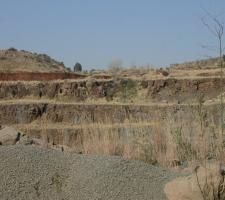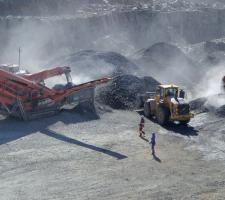
The South African quarry industry’s main adversary to its development is illegal mining, but commercial quarry operators deem the establishment of borrow pits as equally damaging, writes Munesu Shoko.
Around 103 million tonnes/year of aggregate are produced in South Africa, based on 2012/2013 returns and industry estimates. The country’s Department of Mineral Resources (DMR) says this is a significant increase on the 81 million tonnes/year reported between 2010 and 2011.
However, the
The formal quarry industry’s fight against borrow pits is gaining momentum, with the sector going head-on with governing bodies in a bid to level the playing field. The Aggregate and Sand Producers Association of Southern Africa (Aspasa) is at the forefront of this war against the unfair tide of borrow pits. Nico Pienaar, director of Aspasa, says while the formal quarry industry is waging a successful war against illegal mining, it is equally concerned that the chief impediment to stemming unfair practices is the issuing of “unnecessary permits” by authorities for the establishment of borrow pits, especially for road building purposes.
Pienaar says this puts quarry operators in an unfair position. “While our members have to comply with the strictest requirements and up-to-date legislation to protect the industry, illegal miners or hastily set-up borrow pits have no such requirements and spend no money on making the workplace safer or protecting the environment,” he says. “As a result they can easily undercut our members and in some instances place the future sustainability of employment at legally operated quarries in jeopardy.”
Davin Giles, regional manager of Afrimat Western Cape, a major quarry operator in the country, shares the same sentiment with Pienaar, arguing that the biggest dilemma for commercial quarry operations is that they have the obligation to run as long-term sustainable operations, while borrow pits are managed with a short-term approach. He says borrow pit operators don’t stick to the same stringent rules quarry operators have to adhere to, significantly reducing quarry operators’ competitiveness.
He is of the notion that enough legislation is in place to govern these operations, but borrow pits are simply not efficiently policed. He brings to the fore the recent court ruling, which directed that a Land Use Planning Ordinance (Lupo) application is required, together with a mining licence before mining can commence. The Lupo cannot be processed without a National Environmental Management Act (Nema) application.
Giles says both these requirements are expensive and time-consuming, and is adamant this is not the approach taken on the licensing of mining of borrow pits. This is despite that they are bound to comply with both Nema and Lupo stipulations. Pienaar says the DMR is turning a blind eye to the plight of the quarry industry, with major focus placed on laws governing valuable minerals, such as gold, diamonds and platinum.
Meanwhile, Lance Gray, general manager of aggregates at WG Wearne, a construction materials provider, says commercial quarry operators have to face up to the daunting task of applying for a full mining right, which is a time-consuming process by its nature. Compounding this are the requirements of the Mineral and Petroleum Resources Development Act, which generally calls for extensive human resources, time and money. Gray believes that borrow pit operators seem to sidestep these processes. “They simply come in, crush what they need and pack up and go. In most circumstances these pits are not rehabilitated and are left unsafe for the surrounding communities,” he says.
While the DMR is the regulator of both commercial quarries and borrow pits, it is also thought-provoking to note that most borrow pits are operated by state-run organisations, especially the country’s roads agency, the South African National Roads Agency Limited (Sanral) and the ports authority, Transnet.
Elma Lourens, project manager at Sanral, says the main reason why road building authorities opt for borrow pits than established commercial quarries in the vicinity of the projects is the cost benefit.
She argues that these public institutions need borrow pits with quality materials for future rehabilitation and long-term maintenance projects, adding that borrow pits make it hassle-free for Sanral to control and specify its required aggregate specification.
“Commercial sources often cater for a bigger market and are not focused on amending their processes to meet individual client demands,” says Lourens. “In this regard, there is need to open borrow pits to satisfy our own needs,” adding that commercial operations will not supply selected subgrade as per Sanral’s requirements.
Lourens repudiates assertions that borrow pits often sidestep regulatory obligations, arguing that there are no relaxations of the regulations for road authorities and governmental institutions. “We are working with taxpayers’ money and we will only establish borrow pits if there are cost savings in the process.”
Lourens says the cost differentiator between commercially sourced material and material from borrow pits is often realised in transportation expenses. She says Sanral will not open borrow pits in metropolitan areas where commercial quarries are readily available, adding that most commercial quarries locate in central areas and are not jeopardised in the process.
This is a claim Pienaar vehemently disregards, arguing that there has been several instances where borrow pits have been established when an operational commercial quarry locates about 8 to 10km from the project. He says Aspasa is lobbying for a proposition that no borrow pit should be opened if the project it is intended for is less than 30km from a nearby quarry. “If a commercial quarry is close to the project, then no borrow pit should be considered,” says Pienaar.












